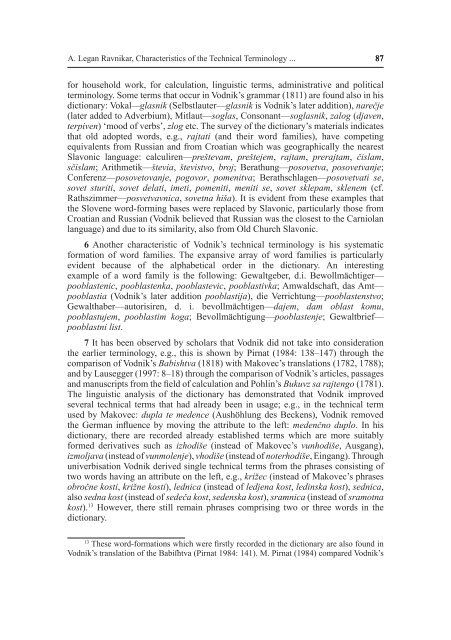Slovenski jezik Slovene Linguistic Studies - KU ScholarWorks
Slovenski jezik Slovene Linguistic Studies - KU ScholarWorks
Slovenski jezik Slovene Linguistic Studies - KU ScholarWorks
Create successful ePaper yourself
Turn your PDF publications into a flip-book with our unique Google optimized e-Paper software.
A. Legan Ravnikar, Characteristics of the Technical Terminology ... 87<br />
for household work, for calculation, linguistic terms, administrative and political<br />
terminology. Some terms that occur in Vodnik’s grammar (1811) are found also in his<br />
dictionary: Vokal—glasnik (Selbstlauter—glasnik is Vodnik’s later addition), narečje<br />
(later added to Adverbium), Mitlaut—soglas, Consonant—soglasnik, zalog (djaven,<br />
terpiven) ‘mood of verbs’, zlog etc. The survey of the dictionary’s materials indicates<br />
that old adopted words, e.g., rajtati (and their word families), have competing<br />
equivalents from Russian and from Croatian which was geographically the nearest<br />
Slavonic language: calculiren—preštevam, preštejem, rajtam, prerajtam, čislam,<br />
sčislam; Arithmetik—števia, števistvo, broj; Berathung—posovetva, posovetvanje;<br />
Conferenz—posovetovanje, pogovor, pomenitva; Berathschlagen—posovetvati se,<br />
sovet sturiti, sovet delati, imeti, pomeniti, meniti se, sovet sklepam, sklenem (cf.<br />
Rathszimmer—posvetvavnica, sovetna hiša). It is evident from these examples that<br />
the <strong>Slovene</strong> word-forming bases were replaced by Slavonic, particularly those from<br />
Croatian and Russian (Vodnik believed that Russian was the closest to the Carniolan<br />
language) and due to its similarity, also from Old Church Slavonic.<br />
6 Another characteristic of Vodnik’s technical terminology is his systematic<br />
formation of word families. The expansive array of word families is particularly<br />
evident because of the alphabetical order in the dictionary. An interesting<br />
example of a word family is the following: Gewaltgeber, d.i. Bewollmächtiger—<br />
pooblastenic, pooblastenka, pooblastevic, pooblastivka; Amwaldschaft, das Amt—<br />
pooblastia (Vodnik’s later addition pooblastija), die Verrichtung—pooblastenstvo;<br />
Gewalthaber—autorisiren, d. i. bevollmächtigen—dajem, dam oblast komu,<br />
pooblastujem, pooblastim koga; Bevollmächtigung—pooblastenje; Gewaltbrief—<br />
pooblastni list.<br />
7 It has been observed by scholars that Vodnik did not take into consideration<br />
the earlier terminology, e.g., this is shown by Pirnat (1984: 138–147) through the<br />
comparison of Vodnik’s Babishtva (1818) with Makovec’s translations (1782, 1788);<br />
and by Lausegger (1997: 8–18) through the comparison of Vodnik’s articles, passages<br />
and manuscripts from the field of calculation and Pohlin’s Bukuvz sa rajtengo (1781).<br />
The linguistic analysis of the dictionary has demonstrated that Vodnik improved<br />
several technical terms that had already been in usage; e.g., in the technical term<br />
used by Makovec: dupla te medence (Aushöhlung des Beckens), Vodnik removed<br />
the German influence by moving the attribute to the left: medenčno duplo. In his<br />
dictionary, there are recorded already established terms which are more suitably<br />
formed derivatives such as izhodiše (instead of Makovec’s vunhodiše, Ausgang),<br />
izmoljava (instead of vunmolenje), vhodiše (instead of noterhodiše, Eingang). Through<br />
univerbisation Vodnik derived single technical terms from the phrases consisting of<br />
two words having an attribute on the left, e.g., križec (instead of Makovec’s phrases<br />
obročne kosti, križne kosti), lednica (instead of ledjena kost, ledinska kost), sednica,<br />
also sedna kost (instead of sedeča kost, sedenska kost), sramnica (instead of sramotna<br />
kost). 13 However, there still remain phrases comprising two or three words in the<br />
dictionary.<br />
13<br />
These word-formations which were firstly recorded in the dictionary are also found in<br />
Vodnik’s translation of the Babiſhtva (Pirnat 1984: 141). M. Pirnat (1984) compared Vodnik’s
















